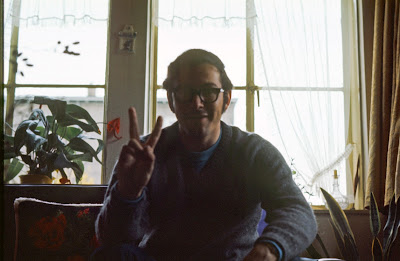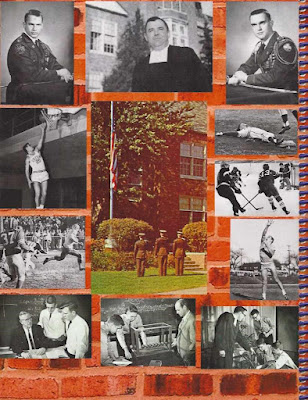Last
summer, my classmates and I celebrated our 60th high school class reunion. Not
surprisingly, it was notable for the absence of several familiar faces, a
couple of classmates wheelchair-bound and the presence of portable oxygen units
scattered about the room. That’s probably not too strange since we’re all in
our late seventies, pushing up against the eighty-year mark and slowing down
considerably. They say it’s called the circle of life.
Now
a year later, a 61st class reunion has been organized. It will be held at a bar/restaurant
in the vicinity of our old high school. I’m guessing some of the wiser ones
among our class leadership decided that with our attrition rate as it is, it
was probably best not to wait another ten years before we all met up again. But
there was another reason for gathering and reminiscing about ‘the good old
days.’
Concurrently
with our 61st reunion, a new book about Cretin has just come out on Amazon.
Com. Its genesis was simple enough. After last year’s class reunion, a couple
of my classmates got together and decided it would be nice to capture some of
the memories of our time from 1957 to 1961 at a unique educational institution
that no longer exists. Thus was born ‘Cretin ’61 A Class Memoir.’
When
I went on Amazon to buy a copy of ‘A Class Memoir’ I discovered another book
about Cretin entitled: ‘Cretin Boy.’ This book was written by a graduate of the
class of 1979. The second, ‘A Class Memoir,’ is by one of my classmates, Joe
Delmont. It turns out that neither one was a romp down memory lane; at least
not for me. Instead both books were a grab bag of other people’s memories; none
of them patterned after my own.
For
what it’s worth, both books, but especially ‘A Class Memoir,’ brought to mind
just how isolated I felt a lot of the time relative to the experiences of my
classmates. Reading ‘Memoir’ made me feel as if I was looking in on four years
of high school that I only heard about in the homeroom, cafeteria, and after
school.
To
their credit, Amazon did a good job describing ‘Cretin Boy:’
‘Cretin
High School, located in Saint Paul, Minnesota was a Catholic, all-male,
military academy that brought unique twists to the already difficult high
school experience. Cretin Boys, as they were called, were subject to the
oppression of both church and state as they navigated the diverse teaching
styles of Christian Brothers, military instructors, and lay teachers. Cretin
Boy looks at those menial first jobs, takes you dancing with a girl at that
first high school formal, and peels down the street in a Corvette-on-loan with
a teen at the wheel. It is a coming-of-age story with a military dress code, a
coming-to-faith story while smoking in the boy’s room.’
My classmate, Joe Delmont along with a
group of friends, collected all the content for this second book of memories of
our class and did a great job with: ‘Cretin ’61 A Class Memoir.’
Amazon described his book this way:
‘What Was It Like To Be Part of This
Group?
Cretin ’61 was founded in 1871 as an
all-male, blue-collar, Catholic, military high school, for day students, one
that emphasized physical discipline and man-to-man directness to teach personal
responsibility and excellence in athletics, academics, and career development
as we grew from boys to men. This school ceased to exist when Cretin dropped
mandatory JROTC and merged with Derham Hall High School. This book is a
snapshot of our school days in 1957-1961.’
On a very personal level, the two books paint
a fascinating picture of a time and place long since relegated to mostly old
black and white photographs and the occasional color print of my high school
years. But a time and period of my life better remembered by other people.
While
the two books did a great job of rehashing old memories of high school; it was
much more personal for me. The books really filled in a vacuum inside my head
that had been there for over 61 years. It further reinforced the notion that my
high school experiences were remarkably different than those of most of my
classmates.
Reading
the ‘Class Memoir,’ one can’t help but feel that many of my classmates who
contributed to the book were truly reliving their ‘glory years.’ That’s not
meant as a criticism but rather an acknowledgement that their experiences
during those four years followed a different trajectory than mine did.
Raised
in a single parent household (my mother left school after the sixth grade)
where education was never talked about, I only had one distant cousin who
seemed to ‘have it together.’ He was attending Cretin High School at the time,
following in the footsteps of his two brothers. After that, he was going to
college, as had his two brothers. Though never discussed, I had the distinct impression
that ‘Buzz’ (Ronald Pizinger - later Doctor Pizinger) was the one to follow. So
I naively thought I would too.
After
being passed by with the first group of applicants, I only got into Cretin
after someone dropped out, and I was next on their wait list. Lucky me! Both
books brought back a plethora of memories; both good and sad but real and
honest, nevertheless.
It
truly was the best of times and the most trying - at times. It was what it was
and both books pointed out the unique educational experience both my class of
1961 and the class of 1979 can hold dear to their heart.
I
can’t change the fact that I felt like an outsider a lot of the time while I
was attending Cretin. I still feel like an outsider some of the times but a
much older one now and able to treasure the gifts I received there.












































